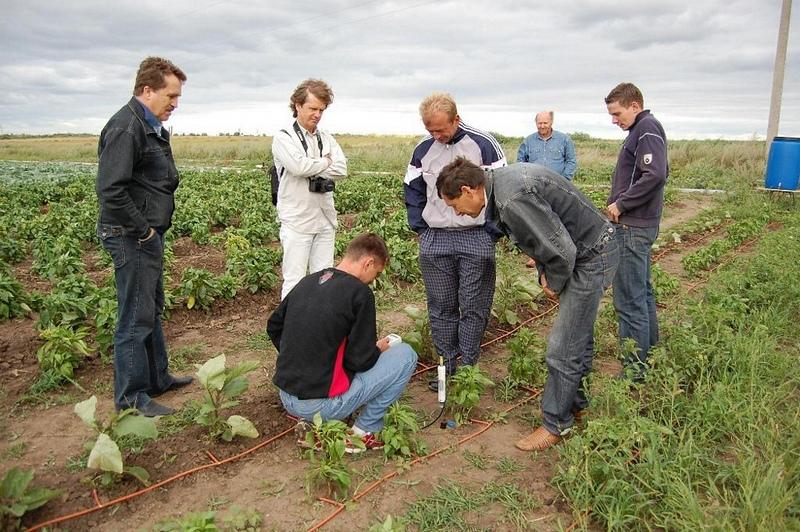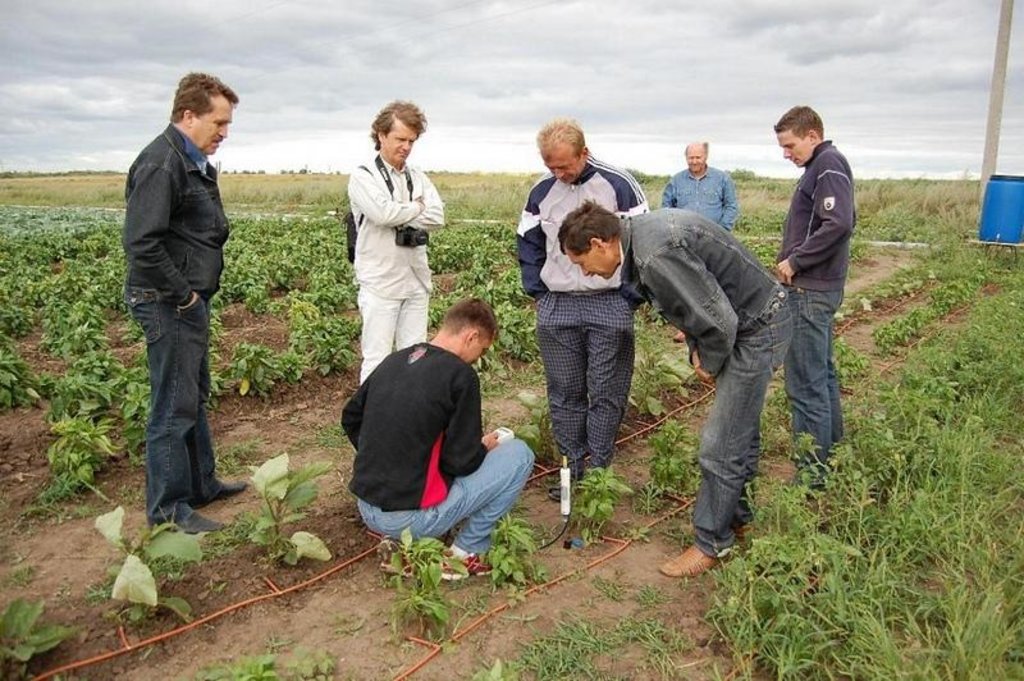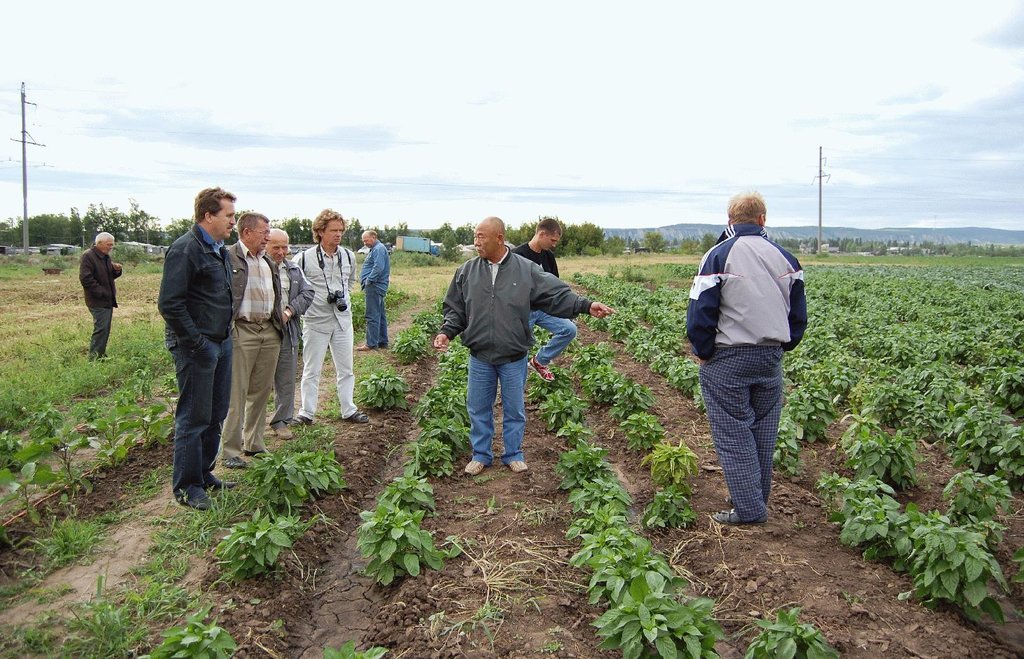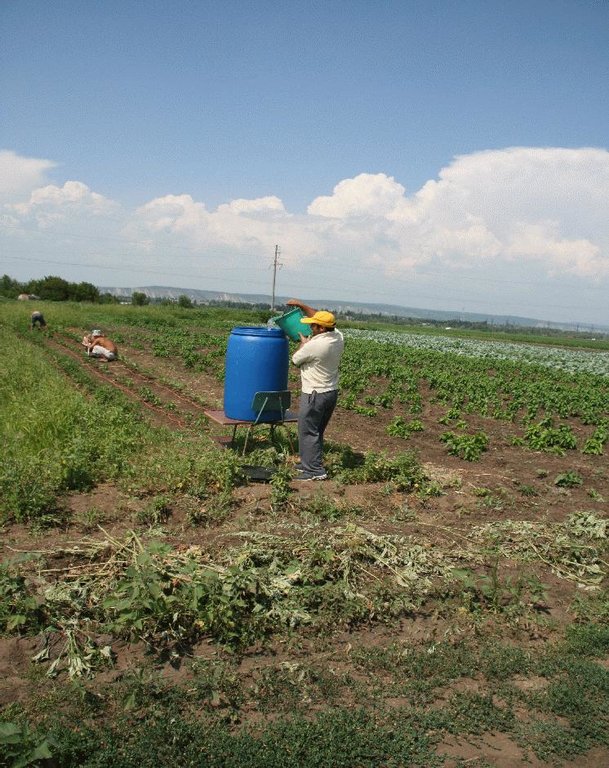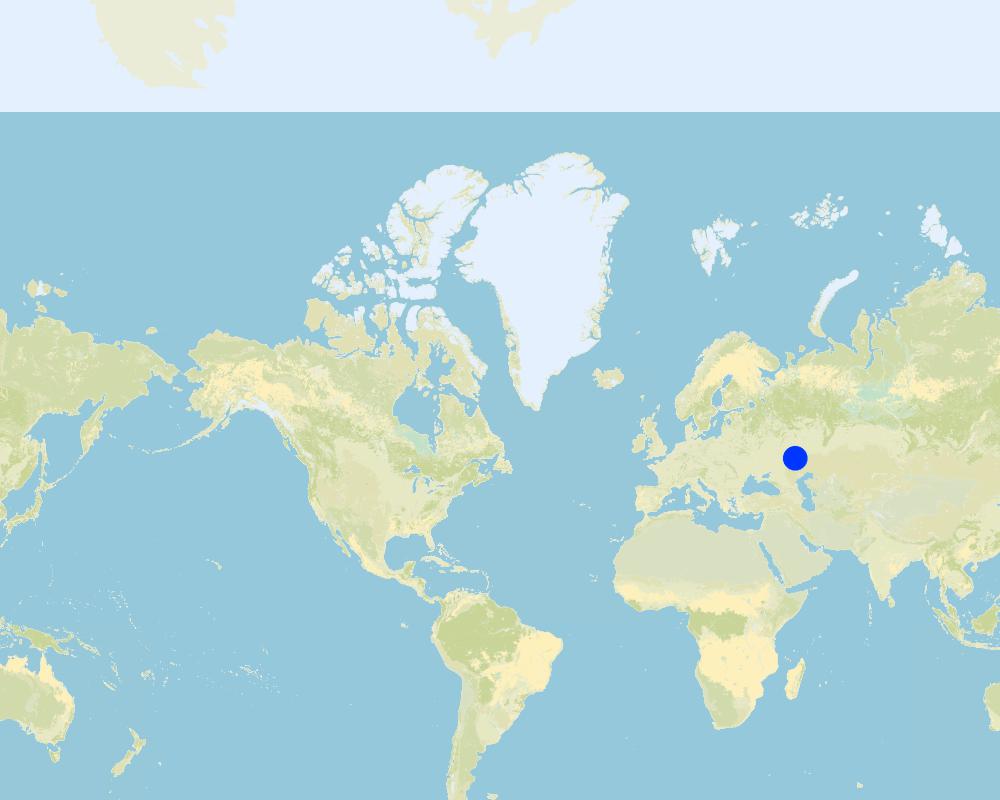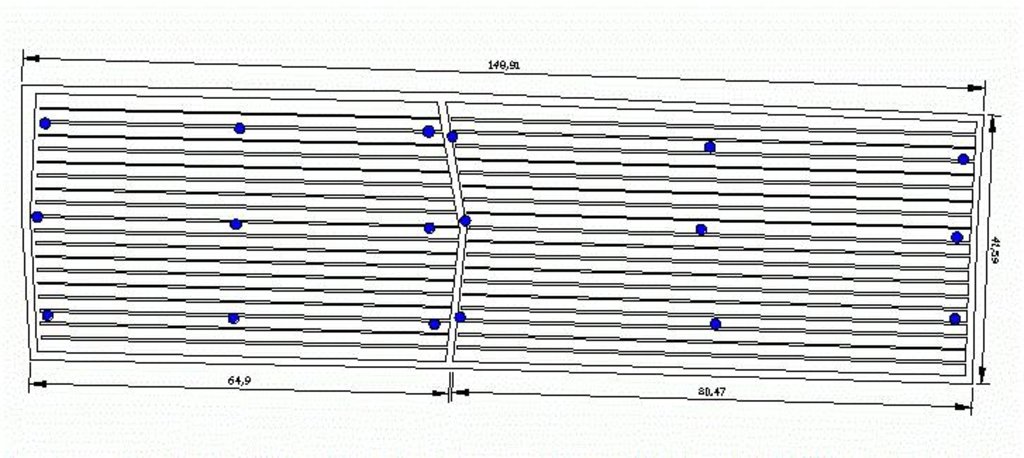Drip irrigation [俄罗斯联邦]
- 创建:
- 更新:
- 编制者: Anatoly Zeyliger
- 编辑者: –
- 审查者: Deborah Niggli, Alexandra Gavilano
Капельное орошение (in Russian)
technologies_1371 - 俄罗斯联邦
查看章节
全部展开 全部收起1. 一般信息
1.2 参与该技术评估和文件编制的资源人员和机构的联系方式
有助于对技术进行记录/评估的项目名称(如相关)
DESIRE (EU-DES!RE)1.3 关于使用通过WOCAT记录的数据的条件
编制者和关键资源人员接受有关使用通过WOCAT记录数据的条件。:
是
1.4 所述技术的可持续性声明
这里所描述的技术在土地退化方面是否存在问题,导致无法被认为是一种可持续的土地管理技术?:
否
1.5 参考关于SLM方法(使用WOCAT记录的SLM方法)的调查问卷
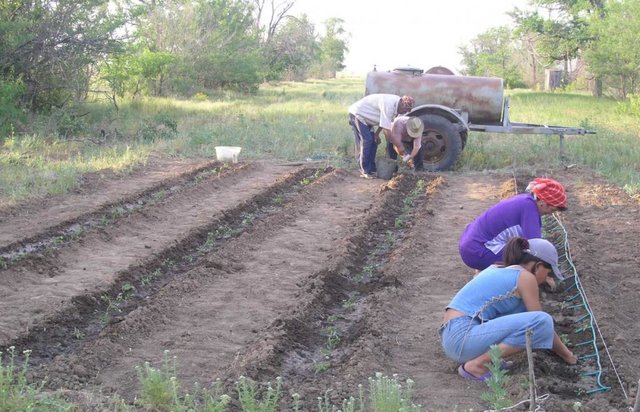
Concerted thinking on common problems of water scarcity [俄罗斯联邦]
Testing and disseminating of a water-saving technology like drip irrigation
- 编制者: Anatoly Zeyliger
2. SLM技术的说明
2.1 技术简介
技术定义:
Drip irrigation systems gradually apply water into the zone around the stem of the irrigated plant.
2.2 技术的详细说明
说明:
Drip irrigation experiments have been carried out on the left bank of the Volga River. Economic problems, regional reforms and shortage of investments in municipal water supply infrastructure led to problems of water quality and quantity of available water for industrial, agricultural and domestic uses. The situation is getting worse with the effects of regional climate change. Especially during summer, the study region has problems with shortage of water not just for irrigation of agricultural fields, or gardens, but also for domestic use. In such situations, more efficient water use is required through introducing water-saving technologies. One of these well-known irrigation technologies is drip irrigation. Small quantities of water are directly delivered to the plants by a pipe system. This technology is the most effective from the point of view of green water use efficiency. Correct application of drip irrigation technology drastically decreases water losses by runoff and evaporation as well as deep percolation to soil depths inaccessible to root uptake. Water can be provided to plants from surface water reservoirs, water tanks or groundwater wells through a network of plastic pipes (under low water pressure) and delivered through a water drip system. The flow rate can be adjusted to the needs of the particular stage of plant growth, to soil hydraulic properties and to the prevailing weather conditions. The low-pressure supply system can be operated using a header tank or directly by using a water pump to raise water from nearby surface water storage or a groundwater well.
The aim of this technology is to show the effectiveness of freshwater usage in irrigating vegetables (tomatoes, peppers) at the scale of subsidiary plots or small irrigation systems (several ha in size) in a region with scarce water resources both as a water-saving measure and an eco-friendly alternative to furrow irrigation. Owing to the relative narrowness of the drip feeders, they are prone to blockages from organic matter, mineral particles or dissolved compounds. To prolong the lifetime of the drip irrigation equipment, it needs to be maintained using preventive and remedial measures such as visual inspection of pipes and water supply sources, filter installations as well as flushing the tubes and drip emitters to remove deposits.
In general, a number of medium-scale farmers are using furrow irrigation of vegetables as their main agricultural activity. Drip-irrigation technology was tested with four families and compared to furrow irrigation in order to compare water consumption (water use efficiency as rate of yield and volume of water used for irrigation) as well as its impact on soil degradation and ground-water. The water use efficiency of drip irrigation is 3 - 10 times higher than that of furrow irrigation, depending on local conditions and qualification of furrow irrigators. Furthermore, this technology avoids water loss through soil surface evaporation, percolation to deep soil layers and ground water, and runoff into near water bodies (causing pollution by chemicals used for agricultural activities at irrigated fields like fertilizers and plant protectors). The negative impact of furrow irrigation on soil productivity is usually very high due to soil erosion.
Experimentations and demonstration of drip irrigation were done at two levels. The first level involved large-scale farms with the aim of demonstrating the considerable gains to be made through the efficient use of water, through the development of representative experimental plots on fields used for furrow irrigation by two farmers. The second level was developed for small-scale farmers and householders to demonstrate the efficiency of water saving in gardening.
2.3 技术照片
2.5 已应用该技术的、本评估所涵盖的国家/地区/地点
国家:
俄罗斯联邦
区域/州/省:
Saratov Region
有关地点的进一步说明:
Marksovsky District
具体说明该技术的分布:
- 均匀地分布在一个区域
如果不知道精确的区域,请注明大致覆盖的区域:
- < 0.1 平方千米(10 公顷)
注释:
Technology now is in testing mode.
Map
×2.6 实施日期
如果不知道确切的年份,请说明大概的日期:
- 不到10年前(最近)
2.7 技术介绍
详细说明该技术是如何引入的:
- 通过项目/外部干预
3. SLM技术的分类
3.1 该技术的主要目的
- 减少、预防、恢复土地退化
3.2 应用该技术的当前土地利用类型

农田
- 一年一作
每年的生长季节数:
- 1
具体说明:
Longest growing period in days: 120, Longest growing period from month to month: May - Sept
注释:
Major land use problems (compiler’s opinion): Scarcity of fresh water resources, change of local seasonal climate patterns related to change in rainfall, scarcity of freshwater resources, soil salinization, disappearance of some species of flora and fauna
Major land use problems (land users’ perception): Scarcity of fresh water resources, change of local seasonal climate patterns related to change in rainfall, scarcity of freshwater resources, soil salinization, disappearance of some species of flora and fauna
Type of cropping system and major crops comments: Some changes in the cropping system can be seen as there are several years of water shortage can be observed.
Livestock is grazing on crop residues
3.4 供水
该技术所应用土地的供水:
- 雨养
3.5 该技术所属的SLM组
- 灌溉管理(包括供水、排水)
- 引水和排水
3.6 包含该技术的可持续土地管理措施

结构措施
- S11:其它
3.7 该技术强调的主要土地退化类型

土壤水蚀
- Wt:表土流失/地表侵蚀

化学性土壤退化
- Cs:盐化/碱化

水质恶化
- Hp:地表水水质下降
注释:
Main causes of degradation: disturbance of water cycle (infiltration / runoff) (Disappearing of water sources produced by spring runoff (ponds). However, this disturbance is natural, appear due to changes in nature. Snow melted water (in the absence of frosted topsoil) infiltrate), inputs and infrastructure: (roads, markets, distribution of water points, other, …) (The water distribution system has no possibilities equally distribute water in village. People living at end of village have no water for domestic use, in beginning all water resouces were taken)
Secondary causes of degradation: change of seasonal rainfall (Quantity of rainfalls decreased)
3.8 防止、减少或恢复土地退化
具体数量名该技术与土地退化有关的目标:
- 减少土地退化
4. 技术规范、实施活动、投入和成本
4.1 该技术的技术图纸
技术规范(与技术图纸相关):
Schematic diagram of an experimental plot with drip irrigation at the large-scale farm level, showing the location of access tubes for soil moisture monitoring
Location: Romashki village. Pallasovsky District
Date: 01/06/2008
Technical knowledge required for field staff / advisors: moderate
Technical knowledge required for land users: moderate
Main technical functions: saving water resources
Secondary technical functions: increase in organic matter, promotion of vegetation species and varieties (quality, eg palatable fodder)
Structural measure: irrigation system
Construction material (other): plastic tubes, water tank
Slope (which determines the spacing indicated above): 1.00%
作者:
Semenov V.
4.2 有关投入和成本计算的一般信息
其它/国家货币(具体说明):
ruble
如相关,注明美元与当地货币的汇率(例如1美元=79.9巴西雷亚尔):1美元=:
35.0
注明雇用劳工的每日平均工资成本:
15.00
4.3 技术建立活动
| 活动 | 时间(季度) | |
|---|---|---|
| 1. | installation of pipe network | |
| 2. | tapping the source of water supply |
4.4 技术建立所需要的费用和投入
| 对投入进行具体说明 | 单位 | 数量 | 单位成本 | 每项投入的总成本 | 土地使用者承担的成本% | |
|---|---|---|---|---|---|---|
| 劳动力 | labour | ha | 1.0 | 60.0 | 60.0 | 100.0 |
| 设备 | tools | ha | 1.0 | 3000.0 | 3000.0 | |
| 技术建立所需总成本 | 3060.0 | |||||
| 技术建立总成本,美元 | 87.43 | |||||
注释:
Duration of establishment phase: 3 month(s)
4.5 维护/经常性活动
| 活动 | 时间/频率 | |
|---|---|---|
| 1. | Reinstallation of pipe network every year |
4.6 维护/经常性活动所需要的费用和投入(每年)
| 对投入进行具体说明 | 单位 | 数量 | 单位成本 | 每项投入的总成本 | 土地使用者承担的成本% | |
|---|---|---|---|---|---|---|
| 劳动力 | labour | ha | 1.0 | 60.0 | 60.0 | 100.0 |
| 技术维护所需总成本 | 60.0 | |||||
| 技术维护总成本,美元 | 1.71 | |||||
注释:
Costs are given for 1 ha of land.
4.7 影响成本的最重要因素
描述影响成本的最决定性因素:
The pipe system is the most determining factor affecting the costs.
5. 自然和人文环境
5.1 气候
年降雨量
- < 250毫米
- 251-500毫米
- 501-750毫米
- 751-1,000毫米
- 1,001-1,500毫米
- 1,501-2,000毫米
- 2,001-3,000毫米
- 3,001-4,000毫米
- > 4,000毫米
有关降雨的规范/注释:
summer time 150-200, annual 300-350
农业气候带
- 半干旱
Thermal climate class: temperate
5.2 地形
平均坡度:
- 水平(0-2%)
- 缓降(3-5%)
- 平缓(6-10%)
- 滚坡(11-15%)
- 崎岖(16-30%)
- 陡峭(31-60%)
- 非常陡峭(>60%)
地形:
- 高原/平原
- 山脊
- 山坡
- 山地斜坡
- 麓坡
- 谷底
垂直分布带:
- 0-100 m a.s.l.
- 101-500 m a.s.l.
- 501-1,000 m a.s.l.
- 1,001-1,500 m a.s.l.
- 1,501-2,000 m a.s.l.
- 2,001-2,500 m a.s.l.
- 2,501-3,000 m a.s.l.
- 3,001-4,000 m a.s.l.
- > 4,000 m a.s.l.
5.3 土壤
平均土层深度:
- 非常浅(0-20厘米)
- 浅(21-50厘米)
- 中等深度(51-80厘米)
- 深(81-120厘米)
- 非常深(> 120厘米)
土壤质地(表土):
- 中粒(壤土、粉土)
表土有机质:
- 低(<1%)
5.4 水资源可用性和质量
地下水位表:
5-50米
地表水的可用性:
匮乏/没有
水质(未处理):
仅供农业使用(灌溉)
5.5 生物多样性
物种多样性:
- 低
5.6 应用该技术的土地使用者的特征
生产系统的市场定位:
- 生计(自给)
- 混合(生计/商业)
非农收入:
- 低于全部收入的10%
相对财富水平:
- 非常贫瘠
- 贫瘠
个人或集体:
- 个人/家庭
机械化水平:
- 手工作业
- 机械化/电动
说明土地使用者的其他有关特征:
Population density: < 10 persons/km2
Annual population growth: < 0.5%
70% of the land users are poor and own 80% of the land.
30% of the land users are poor and own 20% of the land.
5.7 应用该技术的土地使用者使用的平均土地面积
- < 0.5 公顷
- 0.5-1 公顷
- 1-2 公顷
- 2-5公顷
- 5-15公顷
- 15-50公顷
- 50-100公顷
- 100-500公顷
- 500-1,000公顷
- 1,000-10,000公顷
- > 10,000公顷
这被认为是小规模、中规模还是大规模的(参照当地实际情况)?:
- 小规模的
5.8 土地所有权、土地使用权和水使用权
土地所有权:
- 社区/村庄
土地使用权:
- 社区(有组织)
- 个人
用水权:
- 社区(有组织)
- 个人
5.9 进入服务和基础设施的通道
健康:
- 贫瘠
- 适度的
- 好
教育:
- 贫瘠
- 适度的
- 好
技术援助:
- 贫瘠
- 适度的
- 好
就业(例如非农):
- 贫瘠
- 适度的
- 好
市场:
- 贫瘠
- 适度的
- 好
能源:
- 贫瘠
- 适度的
- 好
道路和交通:
- 贫瘠
- 适度的
- 好
饮用水和卫生设施:
- 贫瘠
- 适度的
- 好
金融服务:
- 贫瘠
- 适度的
- 好
6. 影响和结论性说明
6.1 该技术的现场影响
社会经济效应
生产
作物生产
产品多样性
水资源可用性和质量
灌溉用水需求
其它社会经济效应
relatively high costs for purchasing, installation and maintenance
社会文化影响
食品安全/自给自足
contribution to human well-being
注释/具体说明:
This technology will help people to receive more diverse table.
生态影响
水循环/径流
蒸发
土壤
土壤水分
6.2 该技术的场外影响已经显现
no runoff, no water erosion, no ground water rising
6.3 技术对渐变气候以及与气候相关的极端情况/灾害的暴露和敏感性(土地使用者认为的极端情况/灾害)
气候有关的极端情况(灾害)
气候灾害
| 该技术是如何应对的? | |
|---|---|
| 干旱 | 不好 |
6.4 成本效益分析
技术收益与技术建立成本相比如何(从土地使用者的角度看)?
短期回报:
中性/平衡
长期回报:
积极
技术收益与技术维护成本/经常性成本相比如何(从土地使用者的角度看)?
短期回报:
积极
长期回报:
积极
注释:
Even in first year the labour time is much less compare to the labour needed for irrigation by furrows.
6.5 技术采用
- > 50%
注释:
100% of land user families have adopted the Technology with external material support
4 land user families have adopted the Technology with external material support
The system is at an experimental phase.
There is a moderate trend towards spontaneous adoption of the Technology
People are interested in the technology and are watching their benefits on the experimental plots
6.7 该技术的优点/长处/机会
| 土地使用者眼中的长处/优势/机会 |
|---|
| Saving of the water |
| Diversification of crop production |
| 编制者或其他关键资源人员认为的长处/优势/机会 |
|---|
| Saving of the water |
| Diversification of crop production |
| Savings of soil fertility |
6.8 技术的弱点/缺点/风险及其克服方法
| 编制者或其他关键资源人员认为的弱点/缺点/风险 | 如何克服它们? |
|---|---|
| Requires preventive and regular maintenance | monitoring and independent control of water use efficiency as well as through financial instruments (pressure on inefficient users) |
| High investment costs due to expensive pipe system | provide subsidies for drip irrigation user. |
7. 参考和链接
7.1 信息的方法/来源
- 实地考察、实地调查
- 与土地使用者的访谈
(现场)数据是什么时候汇编的?:
20/10/2011
7.2 参考可用出版物
标题、作者、年份、ISBN:
Zeiliguer, A., G. Sokolova, V. Semeonv, O. Ermolaeva. Results of field experimentations at 2008 to grow tomatoes under drip irrigation at Pallasovsky District of Volgograd Region.
可以从哪里获得?成本如何?
Proceeding of conference at MSUEE. 2008, p. 45-56.
链接和模块
全部展开 全部收起链接

Concerted thinking on common problems of water scarcity [俄罗斯联邦]
Testing and disseminating of a water-saving technology like drip irrigation
- 编制者: Anatoly Zeyliger
模块
无模块


